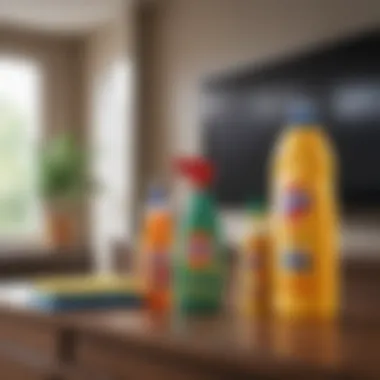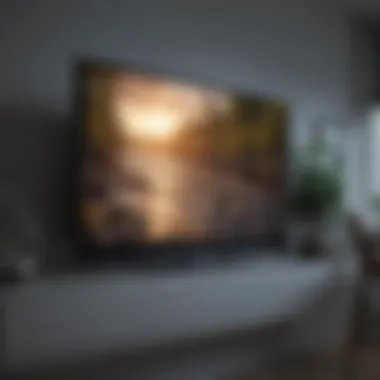Effective Cleaning Techniques for Flat Screen TVs


Intro
Cleaning a flat screen TV is not only about aesthetics but also about maintaining its functionality and extending its lifespan. Given that screens, particularly LCD and OLED variants, display sensitive surfaces, using the wrong cleaning methods can lead to lasting damage. This guide aims to provide practical guidelines for effectively cleaning flat screen TV screens while ensuring the maintenance of their quality over time.
Flat screens have become a staple in modern homes, enhancing the way we consume visual content. However, the importance of proper screen care often gets overlooked. With a rising focus on ensuring optimal viewing experiences, understanding the intricacies involved in screen cleaning is essential. Throughout the article, we will discuss key aspects such as recommended cleaning materials, effective techniques, and regular maintenance routines tailored to various flat screen technologies.
Key Points to Discuss
- Materials and Solutions: Identifying appropriate cleaning solutions that are safe for your particular screen type.
- Cleaning Techniques: Effective approaches for cleaning without risking damage.
- Routine Maintenance Tips: Strategies for upholding screen integrity and longevity.
"Maintaining your flat screen TV is as crucial as its initial purchase. A clean screen enhances picture quality, while a well-kept television ensures a longer life span."
By delving into these topics, you will be equipped with the essential knowledge to clean your flat screen television effectively, minimizing risks and enhancing your viewing enjoyment. Let's explore the crucial elements of this process.
Understanding Flat Screen TV Technology
Understanding flat screen TV technology is crucial for ensuring effective cleaning and maintenance. As the technology evolves, different types of screens exhibit unique characteristics that impact both image quality and the proper handling required during cleaning. Knowledge of the basic technology can help avoid common mistakes and extend the longevity of your television set.
Types of Flat Screen TVs
LCD, which stands for Liquid Crystal Display, is a type of screen widely recognized for its affordability and decent picture quality. One of the main benefits of LCDs is their lightweight and slim profile, making them easy to mount on walls. The unique feature of LCDs is their use of liquid crystals sandwiched between two layers of glass, allowing them to change light intensity and create images. However, LCDs can struggle with viewing angles. This means that picture quality can deteriorate when viewed from the side.
LED
LED refers to Light Emitting Diode TVs, which are essentially an advancement of LCD technology. They use LED backlighting instead of traditional fluorescent lighting, resulting in improved brightness and contrast. This makes LED TVs a popular choice among consumers looking for vibrant colors and deeper blacks. One notable advantage of LED TVs is energy efficiency, as they consume less power compared to older technologies. However, this can come at a cost; LED TVs may exhibit some blooming effects in high-contrast scenes, affecting the viewing experience in certain scenarios.
OLED
OLED stands for Organic Light Emitting Diodes. Unlike LCD and LED TVs, OLED screens do not require backlighting. Each pixel emits its own light, providing true blacks and a superior contrast ratio. This technology contributes to stunning visuals and is favored by many high-end users. A key characteristic of OLED is its flexibility, allowing for ultra-thin screens. However, potential drawbacks include a higher price point and a risk of burn-in if static images are displayed for extended periods.
Screen Coatings and Their Implications
Understanding screen coatings is vital for effective maintenance, as these coatings directly influence the care required.
Anti-glare Coatings
Anti-glare coatings are designed to reduce reflections and enhance visibility in bright environments. These coatings diffuse ambient light, making it easier to enjoy your TV without constant adjustments to lighting conditions. The main benefit of such coatings is improved viewing comfort. However, they can slightly affect the sharpness and color accuracy of the image when compared to non-coated screens.
Fingerprint-resistant Coatings
Fingerprint-resistant coatings aim to minimize smudges and greasy fingerprints that can accumulate over time. They provide an essential layer of protection, especially in households with children or pets. One of the key characteristics is their hydrophobic property, which repels oils and moisture. While these coatings help keep screens clean for longer, they may require specific cleaning solutions to maintain their efficacy without degrading over time.
Understanding the technology and coatings of flat screen TVs ensures you use the appropriate methods and materials during cleaning, which is fundamental to preserve their functional quality.


The Importance of Regular Cleaning
Cleaning your flat screen TV is often an overlooked task, yet it is crucial for maintaining both the quality and longevity of the device. The accumulation of dust and grime can detract from the viewing experience and may even cause permanent damage to the screen. A comprehensive understanding of why regular cleaning is important can help you develop a better cleaning routine and enhance the performance of your television.
Impact on Image Quality
The image quality of a flat screen TV can significantly diminish due to dust and smudges. Dust particles scatter light, leading to a hazy or blurred picture. When the screen is not clean, colors may appear dull or washed out. Regular cleaning removes these particles, allowing the display to perform at its best. It ensures that you experience the rich colors and sharp contrasts that modern technology can offer. Furthermore, neglecting to clean may lead to more serious issues. For instance, oils from fingerprints can harden over time, making them more difficult to remove and potentially damaging the screen's coating.
Prevention of Dust Accumulation
In addition to enhancing image quality, regular cleaning helps minimize dust accumulation. Flat screen TVs are more sensitive to dust than traditional tube televisions. The smaller components within can easily become obscured if not maintained properly. A clean screen also means a cleaner surrounding area. When dust settles on the TV, it can spread to nearby furniture and surfaces, creating an unkempt home environment. Establishing a routine, such as dusting the screen weekly, can significantly reduce the amount of debris that collects in both the screen and the living space.
"Regular maintenance is key to the longevity of your device. A clean screen is not just for aesthetics; it’s essential for performance."
Essential Cleaning Supplies
The role of cleaning supplies in maintaining flat screen TVs cannot be underestimated. Choosing the right materials is essential. Use items that will not damage the sensitive screens and will effectively remove dirt and smudges. This is key to preserving screen quality and enhancing viewing experiences. When cleaning flat screens, there are specific tools and solutions that provide the best results without causing harm.
Microfiber Cloths
Microfiber cloths are widely considered the best option for cleaning flat screen TV screens. Their unique structure allows them to capture dust and dirt without scratching the surface. A high-quality microfiber cloth will not leave lint behind, which is crucial for keeping screens clear. Another benefit is durability. These cloths can be washed and reused often, making them a cost-effective choice. It is important, however, to ensure they are clean before each use. A dirty cloth could potentially cause scratches instead of preventing them.
Cleaning Solutions
When it comes to cleaning solutions, there are several effective options that are safe for flat screen TVs.
Distilled Water
Distilled water is often recommended for cleaning screens due to its purity. It is free from minerals and impurities that could leave marks. This makes distilled water a beneficial choice, as it effectively cleans without risk of streaks. Users can apply it directly to a microfiber cloth instead of spraying it on the screen. This method reduces the chances of liquid entering the device. The key characteristic of distilled water is its neutrality; it does not introduce additional chemicals that could damage screen coatings.
Vinegar Solutions
Vinegar solutions can also be effective for cleaning flat screen TVs. The acetic acid in vinegar helps break down grime without harsh chemicals. When mixed with distilled water, it creates a gentle cleaning solution that is popular among many users. This mix can effectively tackle stubborn fingerprints or smudges. However, its smell can be off-putting for some, which is a consideration for those who are sensitive to odors.
Commercial Screen Cleaners
Commercial screen cleaners are specially formulated for electronic displays. They are designed to clean effectively without harming screen coatings. Many options on the market are designed specifically for televisions, which means they often have the right balance of cleaning power and safety. Users appreciate the convenience of these products. But it is essential to choose products free from alcohol, ammonia, and other harmful substances.
Avoiding Harmful Materials
Certain materials must be avoided when cleaning flat screen TVs to prevent damage. Using harmful materials can lead to costly repairs or replacements.
Paper Towels
Paper towels are readily available and might seem like a quick solution. However, they can scratch the screen due to their rough texture and abrasiveness. Additionally, they may leave lint and fibers behind, which can be annoying. For this reason, it is better to opt for softer materials like microfiber cloths that will not compromise the screen’s surface. The main feature of paper towels is convenience, but this could backfire. They are not ideal for this delicate task.


Windex
Windex is a popular household cleaner, but its use on flat screen TVs is highly discouraged. This cleaner contains ammonia and similar substances that can strip protective screen coatings. While it might clean well, the potential for damage makes it a poor choice for caring for televisions. Many users find it tempting because it is effective on various surfaces. However, when it comes to screens, safety should come first. Using products specifically designed for screen cleaning is wise to avoid issues.
Step-by-Step Cleaning Process
Cleaning a flat screen TV screen is more than just surface-level maintenance. The step-by-step cleaning process is essential because it not only enhances viewing quality but also prolongs the lifespan of the TV. Unorganized cleaning can lead to scratches or other damage that affects the visual experience. Each phase of the process serves a purpose, ensuring the TV remains in prime condition while minimizing risks associated with improper cleaning methods.
Initial Setup
Unplugging the TV
Unplugging the TV is a critical first step in the cleaning process. This action eliminates any risks of electrical shock and protects the television from potential damage during cleaning. It is a practical measure that contributes to the overall safety of the cleaning routine. The key aspect of unplugging the TV is the prevention of accidental power-on while you are handling sensitive surfaces. This is especially significant when using liquid solutions that could inadvertently drip onto electronic components. The unique benefit of this step is that it assures a more relaxed environment to focus on the cleaning tasks. While it may seem basic, this precaution sets a tone of carefulness in the rest of the cleaning process.
Choosing the Right Environment
Choosing the right environment for cleaning your TV is also vital. Ideally, you should find a well-lit, dust-free area. A clean environment minimizes the chances of additional grime or dust settling on the screen after you've just cleaned it. Setting up in an appropriate space can enhance the effectiveness of your cleaning efforts. The unique feature of this choice is that it reduces the need for repeated cleaning. If you do not select a suitable space, dirt could resettle on the freshly cleaned screen, which defeats the purpose of your efforts. Selecting a quieter, less cluttered room allows for better focus on the task and protects your electronic equipment from accidental contact with cleaning products.
Dusting the Surface
Before applying any cleaning solutions, it is crucial to dust the surface of the screen. Use a dry microfiber cloth to gently wipe away dust particles. This prevents scratching the delicate screen during the wet cleaning phase. The benefit of this initial dusting is that it prepares the screen effectively for deeper cleaning, ensuring that stubborn marks do not get ground in. Light, circular motions are suggested to lift the dust from the screen. Avoid using any materials that could be abrasive.
Cleaning Stubborn Marks
Sometimes, despite regular cleaning, stubborn marks may persist on the screen. This is where targeted cleaning techniques come into play. Spot treatment techniques focus on problem areas without affecting the rest of the screen. Using a damp microfiber cloth with a suitable cleaning solution allows for effective removal of these marks. A critical advantage of this approach is minimizing the risk of water damage to areas that do not require intense cleaning. By isolating the cleaning effect, you ensure that your efforts are concentrated, enhancing overall results.
Spot Treatment Techniques
Spot treatment techniques involve applying a small amount of cleaning solution directly onto a microfiber cloth. It is safer than spraying directly on the screen, which can lead to excess moisture seeping into the device. The direct application minimizes the risk of damaging sensitive internal components. Use gentle, circular motions to treat the marked areas specifically. The power of this technique lies in its precision. You address trouble spots without disrupting the clean areas, ensuring effective results with less effort. Recognizing stubborn marks is the first step; knowing how to treat them effectively guarantees that your TV stays looking crisp and clear.
Final Wipe Down
The final wipe down is the last stage of the cleaning process. This crucial step helps to remove any remaining residue from the cleaning solution or any newly settled dust. Using a clean, dry microfiber cloth, gently wipe the screen in one direction to avoid streaking. A smooth final wipe is essential because it enhances clarity and ensures a seamless viewing experience. Ensuring that residues are not left behind diminishes the likelihood of spotting or marks appearing soon after cleaning. Taking this last step is simple yet immensely impactful, reinforcing the results achieved during the previous steps.
Maintaining Your Flat Screen TV
Maintaining a flat screen TV is essential for its longevity and optimal performance. Regular upkeep not only improves viewing quality but also prevents potential issues that could arise from neglect. Flat screen TVs are an investment, and proper care ensures they remain in excellent condition for years. The two primary considerations in maintaining a flat screen involve adhering to a regular cleaning schedule and implementing protective measures that can safeguard the screen from damage.
Regular Cleaning Schedule
Creating a regular cleaning schedule is a vital component of flat screen TV maintenance. Dust and fingerprints accumulate on the screen over time, affecting picture quality. A consistent cleaning routine helps to mitigate this build-up and keep the screen clear. Here are key aspects to consider when setting up a cleaning schedule:
- Frequency: Depending on your environment, consider cleaning your TV's screen weekly or bi-weekly. High-traffic areas may require more frequent cleaning.
- Method: Use gentle methods and appropriate tools, such as microfiber cloths, to avoid scratching or damaging the screen surface.
- Time: Plan for cleaning your TV during less busy times, such as weekends or after significant TV usage.
By being proactive with cleaning, you can sustain both the image clarity and the overall aesthetic of your entertainment setup.


Protective Measures
Implementing protective measures is another key element in maintaining your flat screen TV. These steps help reduce the risk of damage and prolong the device's lifespan:
- Placement: Ensure that the TV is placed away from direct sunlight. Prolonged exposure can cause fading in screen colors and potentially damage the internal components.
- Screen Protectors: Consider using a screen protector designed for flat screens. This thin film can shield against scratches, dust, and fingerprints without affecting display quality.
- Environmental Control: Maintaining an appropriate level of humidity in the room can prevent dust accumulation and electronic malfunctions. Avoid areas prone to excessive moisture or dampness.
- Avoiding Liquid Near the Screen: Keep beverages and other liquids at a safe distance from the TV. Spills can cause irreversible damage.
"A clean and well-protected flat screen TV is more likely to deliver a satisfying viewing experience and function efficiently for a longer time."
Addressing Common Mistakes
Cleaning a flat screen TV can seem straightforward, but several common mistakes can lead to damage, decreased performance, and unpleasant viewing experiences. Understanding these pitfalls is essential for maintaining the quality and longevity of your television. By addressing common mistakes in cleaning, you can ensure your screen remains clean, clear, and unblemished. This guide aims to educate you on critical elements and considerations that can enhance your cleaning routines and boost your TV's performance.
Using Excessive Force
One prevalent error is applying excessive force when cleaning the screen. Flat screen TVs, especially LCD and OLED models, have delicate surfaces that can easily be damaged. When using cloths to wipe down the screen, it is crucial to be gentle. Rough scrubbing can scratch the surface or, worse, lead to dead pixels.
Consider these points when cleaning:
- Be Gentle: Use light pressure. Employing too much force will not only risk scratches but could also lead to screen distortion.
- Opt for Microfiber: Microfiber cloths are effective because they lift dirt without scratching. They provide a gentle yet thorough cleaning experience.
"Always use soft fabrics and avoid aggressive techniques that can harm the screen."
Ignoring Manufacturer Guidelines
Another significant mistake is overlooking the manufacturer's cleaning recommendations. Each TV brand has specific instructions for care and cleaning. Ignoring these guidelines can invalidate warranties or cause damage.
Keep these considerations in mind:
- Review the User Manual: Most manuals contain specific cleaning instructions. Adhering to these can prevent harm to the screen.
- Use Recommended Products: Only use cleaning solutions that manufacturers endorse. Homemade solutions or harsh chemicals can react adversely with screen coatings.
Overall, taking time to understand and follow these common mistakes will help in maintaining both the appearance and functionality of your flat screen TV.
Ending
In concluding the guide on cleaning flat screen TV screens, it is essential to recognize the significance of maintaining screen quality. Regular cleaning not only improves image clarity but also prolongs the lifespan of the television. Understanding the various types of flat screens and their specific needs ensures that cleaning methods do not inadvertently damage delicate surfaces.
Summarizing Best Practices
To encapsulate the best practices identified throughout this article, the following points should be considered:
- Use appropriate cleaning materials: Microfiber cloths and specific cleaning solutions are vital. The products used can significantly affect both the cleanliness and condition of your screen.
- Establish a cleaning routine: Depending on usage frequency, establishing a schedule for cleaning can help manage dust and stains before they accumulate.
- Follow manufacturer's guidelines: Ignoring these can lead to unintentional harm to the television. Always refer to the user manual for tailored advice.
By adhering to these best practices, owners can maintain the optimal condition of their TVs, enhancing the viewing experience over time.
Encouraging Safe Cleaning Habits
Lastly, it is crucial to promote safe cleaning habits. These practices will not only further protect the television but also ensure a safe cleaning environment:
- Avoid using harmful substances: Products like ammonia or paper towels should be avoided due to their potential to scratch or damage the screen surface.
- Consider lighting conditions: Ensure adequate lighting when cleaning to avoid missing spots that may need attention.
- Turn off the TV before cleaning: This not only enhances visibility of smudges but also reduces the risk of electrical issues during the cleaning process.
“Safe habits create an environment for both cleanliness and longevity, ultimately benefiting the television and the viewing experience.”
By cultivating these habits, individuals can ensure that their cleaning routines are both effective and respectful of their electronic investments, contributing to a pleasurable viewing experience.















